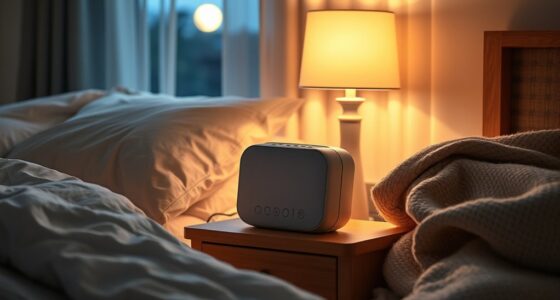If you’re looking for the best grit-testing assessment kits to measure perseverance in 2025, I recommend checking out options like the TSUBOSAN Japan-Hardness Tester, alloy files, and the Measuring Roughness Sample Kit—they offer reliable, accurate evaluations for surface resilience. Additionally, the Landical Moh’s Hardness Test Kit and porting kits like the Merit APK-MO provide versatile testing features. Keep exploring these tools to find the best fit for your needs and discover more about their capabilities.
Key Takeaways
- Grit-testing assessment kits often include mineral, grit, and surface roughness evaluation tools for perseverance measurement.
- Reliable kits feature validated calibration standards to ensure consistent, accurate grit and durability assessments.
- Portable, field-ready kits with compact design support ongoing perseverance evaluation in various environments.
- Kits with comprehensive components—like mineral specimens and abrasive tools—allow detailed grit and surface testing.
- Cost-effective options with user-friendly features suit both professionals and learners aiming to measure perseverance in 2025.
TSUBOSAN Japan-Hardness Tester Checker File HRC40-HRC65 Set of 6
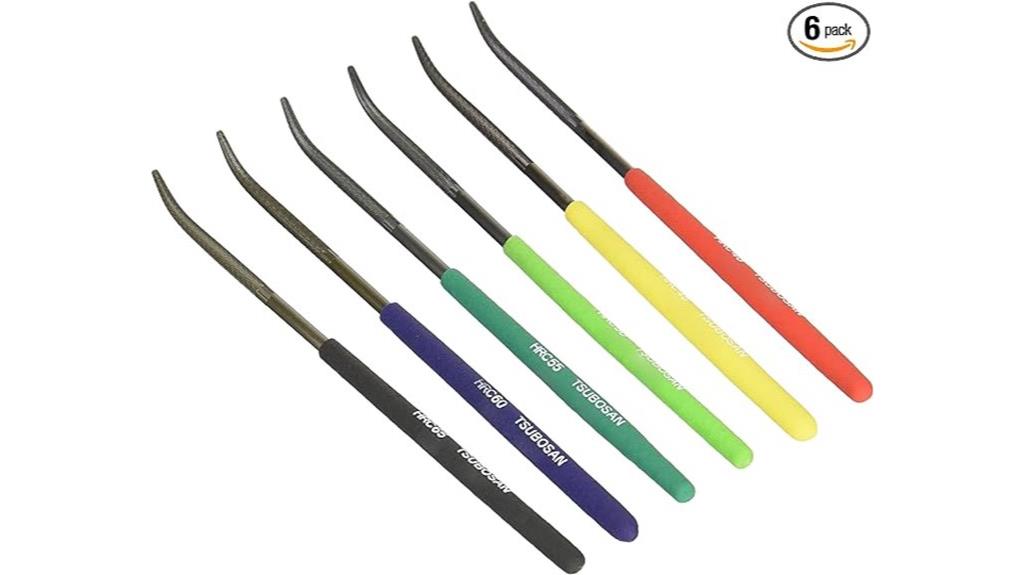
If you’re looking for a reliable tool to test steel hardness without damaging the material, the TSUBOSAN Japan-Hardness Tester Checker File set is an excellent choice. This set includes six alloy steel files with a polished exterior, designed to measure hardness levels from HRC40 to HRC65. The files won’t scratch steel if the hardness exceeds the printed value, ensuring accurate readings and preserving your material. Lightweight at just 8.1 ounces, it features an ambidextrous handle and a custom case for easy storage. No batteries or extra components are needed, making this set simple, efficient, and perfect for quality control.
Best For: professionals and quality control inspectors who need a reliable, non-damaging way to test steel hardness levels accurately.
Pros:
- Accurate hardness testing from HRC40 to HRC65 without scratching the material
- Durable alloy steel construction with polished finish for longevity and precision
- Compact, lightweight design with easy-to-use ambidextrous handle and custom case
Cons:
- Handle attachment is non-mechanical, which may be less secure for some users
- Limited to testing only steel hardness within specified range, not suitable for other materials
- No electronic components or batteries required, which might limit advanced features
Test Kit 1 PR,2040-KT001
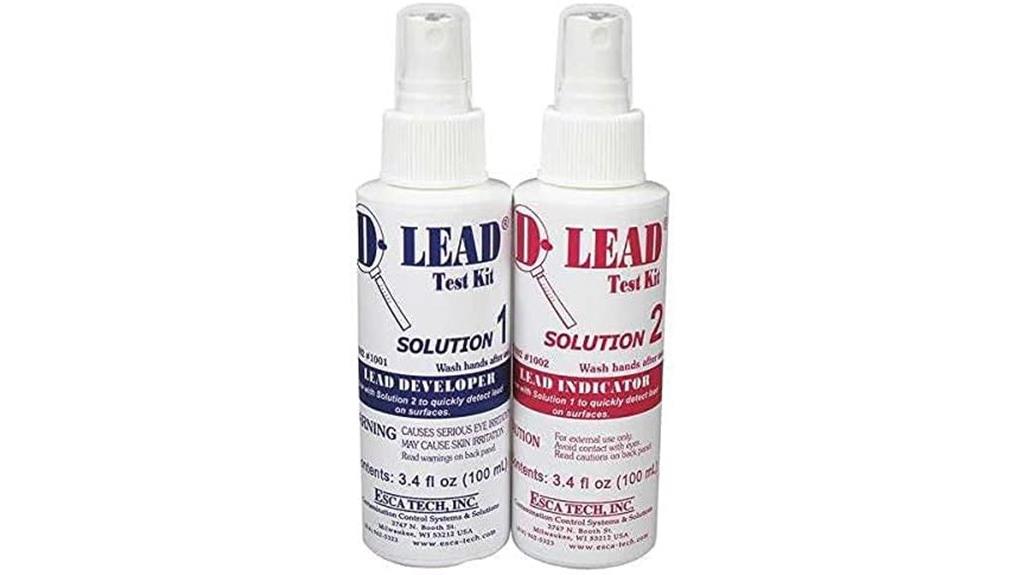
Looking for a reliable refill test kit to assess grit levels accurately? Test Kit 1 PR,2040-KT001 by Grainger Approved is an excellent choice. It’s a refill item designed specifically for grit testing, first available in July 2021. This kit offers precise, manufacturer-supported results and comes with a 30-day Amazon return guarantee. Its straightforward design and clear technical details make it easy to use. Plus, users can report lower prices online or offline to help keep costs competitive. If you need a dependable, easy-to-access test kit for measuring perseverance, KT001 is a solid option worth considering.
Best For: individuals or professionals seeking a reliable, easy-to-use refill test kit for accurate grit level assessment and quality control.
Pros:
- Precise and manufacturer-supported results for dependable testing
- Easy to use with straightforward design and clear technical details
- Comes with a 30-day Amazon return guarantee for peace of mind
Cons:
- Limited to grit testing, may not suit all testing needs
- Only available as a refill kit, requiring prior kit purchase for use
- Price may vary; users need to report lower prices to ensure competitive costs
ASA TECHMED 7-Piece Silver Diagnostic Kit

The ASA TECHMED 7-Piece Silver Diagnostic Kit stands out as an ideal choice for healthcare professionals and students who need a compact, high-quality set of essential diagnostic tools. Its durable stainless steel construction guarantees precision and longevity, making it suitable for daily use. The kit includes crucial tools like tuning forks, a Taylor Hammer, a pupil gauge penlight, and a Snellen eye chart, enabling thorough assessments. Its compact design (11.61 x 6.1 x 1.89 inches) and zipper case make it easy to carry and store. Combining affordability and functionality, this kit offers excellent value for those needing reliable diagnostic equipment on the go.
Best For: healthcare professionals and students seeking a durable, comprehensive, and portable diagnostic toolkit for everyday medical assessments.
Pros:
- Made from durable stainless steel for long-lasting, precise tools
- Compact design with a zipper case for easy transport and storage
- Includes essential diagnostic tools such as tuning forks, Taylor Hammer, and a Snellen eye chart
Cons:
- Limited to basic diagnostic equipment, may not cover all specialized needs
- The compact size might be restrictive for larger or more complex procedures
- Available only in Silver and Tactical Black, limiting color options
Measuring Roughness Sample Kit with 4 Variants

Engineers and machinists seeking accurate surface assessments will find the Measuring Roughness Sample Kit with 4 Variants an invaluable tool. This set includes four distinct flat grinding roughness samples, allowing for thorough evaluation and easy comparison of finishes across different applications. It supports roughness measurement across seven machining techniques, such as vertical milling and grinding, ensuring versatility. Made from durable 45 carbon steel, the samples resist wear and maintain their shape over time. The kit features a clear comparison table with labeled models for quick identification, making it user-friendly in professional settings. Always verify size compatibility to ensure it fits your equipment.
Best For: engineers and machinists who need precise and reliable surface roughness evaluation across multiple machining techniques.
Pros:
- Includes four distinct samples for comprehensive finish comparison.
- Supports measurement across seven different machining methods, enhancing versatility.
- Made from durable 45 carbon steel with a protective oil film for longevity and shape retention.
Cons:
- Size compatibility should be verified beforehand to ensure proper fit with existing equipment.
- May require familiarity with surface roughness standards for effective use.
- The kit’s effectiveness depends on proper calibration and handling during measurement.
Asbestos Test Kit 1 PK (5 Bus. Days) Schneider Labs
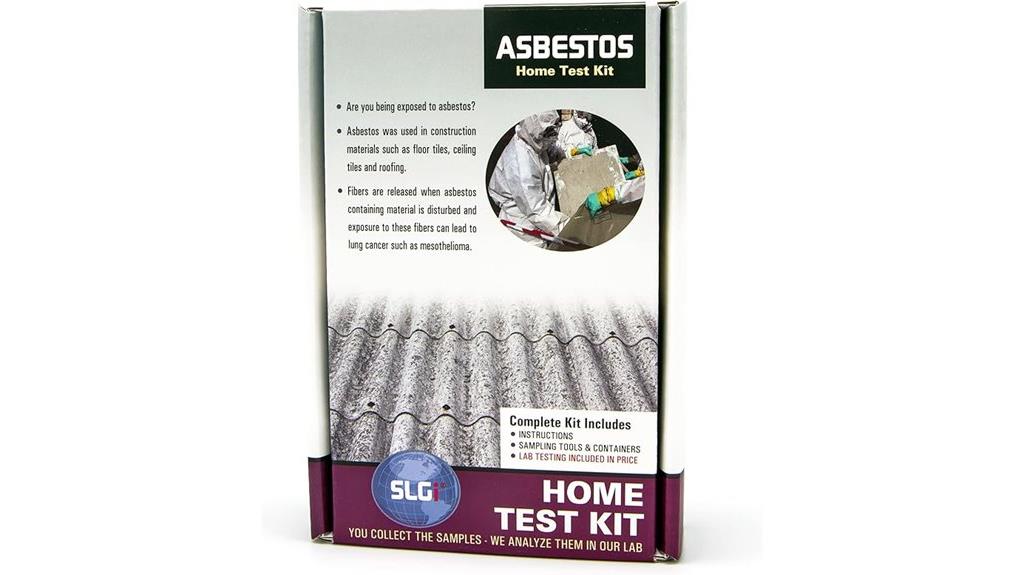
If you’re concerned about asbestos in your home or property, the Asbestos Test Kit 1 PK from Schneider Labs offers a reliable and straightforward solution. It’s designed for PLM analysis of a single sample, with results typically available within 5 business days. The cost covers lab fees, return shipping, expert consultation, and sampling media. You just need to submit your sample using the provided media, and Schneider Labs handles the rest. Keep in mind, samples from loose fill attic or bulk vermiculite are automatically considered asbestos-containing, regardless of appearance. This kit ensures thorough testing and expert support, giving you peace of mind quickly and efficiently.
Best For: homeowners and property owners seeking quick, reliable asbestos testing with expert support to ensure safety and compliance.
Pros:
- Fast turnaround time of 5 business days for test results.
- Cost includes lab fees, return shipping, expert consultation, and sampling media, providing comprehensive service.
- Simple sample submission process using provided sampling media, with clear guidelines.
Cons:
- Only one sample can be tested per kit; additional samples require separate purchase.
- Loose fill attic or bulk vermiculite samples are automatically considered asbestos-containing, limiting testing options for these materials.
- Turnaround time begins upon receipt of the test kit, so shipping delays could affect overall timing.
Landical Moh’s Hardness Test Kit (11 Pieces)
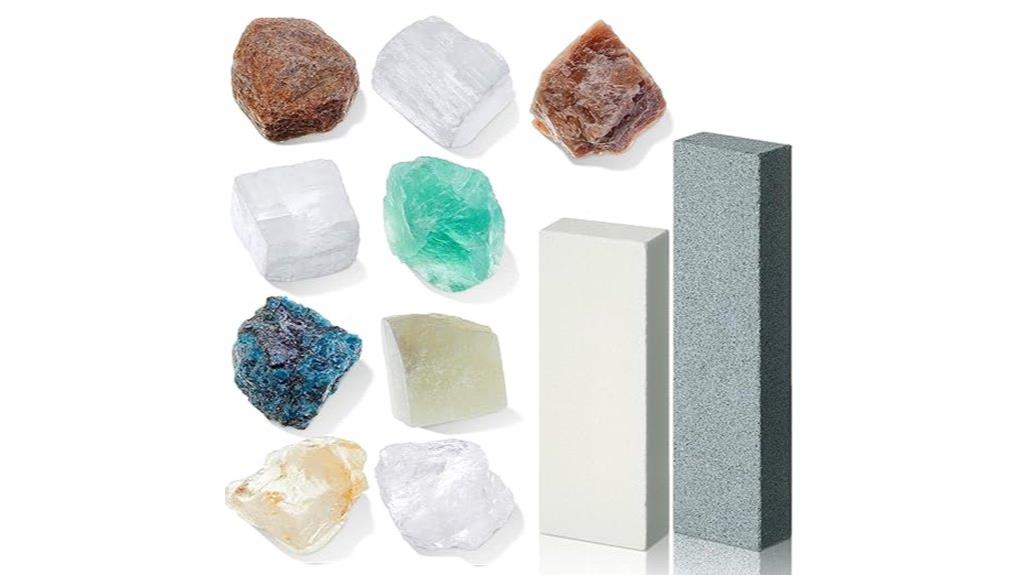
Designed for both geology enthusiasts and professionals, the Landical Moh’s Hardness Test Kit (11 Pieces) offers a reliable way to identify minerals through their hardness levels. It includes nine mineral specimens, such as Talc, Quartz, and Topaz, along with two unglazed porcelain streak plates. The specimens are precisely processed, about an inch each, ensuring clear identification. The kit is compact, portable, and easy to use, making it ideal for hands-on mineral research, educational activities, or fieldwork. Whether you’re exploring rocks at home or in the lab, this kit helps you accurately determine mineral hardness and deepen your geological understanding.
Best For: geology enthusiasts, students, and professionals seeking an accurate, portable tool for mineral identification and hardness testing.
Pros:
- Includes a comprehensive set of mineral specimens and streak plates for versatile testing
- Compact, lightweight design makes it ideal for fieldwork and educational use
- Manually processed specimens ensure clear, reliable identification results
Cons:
- Limited to mineral specimens included; may not cover all mineral types
- Requires some basic knowledge of mineral hardness to interpret results effectively
- The small size of specimens and streak plates may be less suitable for very detailed examinations
Merit 8834169032 Porting Test Kit “APK-MO” (Pack of 1)

For professionals and hobbyists working on metal porting, the Merit 8834169032 Porting Test Kit “APK-MO” stands out as an essential tool. It includes a hard tapered stone for precise initial cuts on tough cast iron surfaces, along with grind-polishing rolls in various sizes and grits for detailed finishing. The Mini Grind-O-Flex Wheel is perfect for light polishing tasks, while the butterfly flapper with abrasive cloth strips excels at internal surface finishing. Designed for general metalworking, automotive, woodworking, and home projects, this kit simplifies porting, grinding, and polishing, making it invaluable for achieving smooth, accurate results in detailed work.
Best For: professionals and hobbyists engaged in metal porting, grinding, and finishing tasks across automotive, woodworking, and home projects who require precise and versatile abrasive tools.
Pros:
- Includes a variety of abrasive tools for multiple finishing and porting applications
- Designed for detailed work on tough materials like cast iron and internal surfaces
- Suitable for both professional and hobbyist use, enhancing workflow efficiency
Cons:
- May require additional tools or accessories for specific applications not included in the kit
- The mini grind wheel is intended for light polishing, not heavy metal removal
- Some users might find the assortment of grits and sizes overwhelming for simple tasks
Gray Diagnostic Reading Tests GDRT-2 (Complete Kit)

The Gray Diagnostic Reading Tests GDRT-2 (Complete Kit) stands out as an essential tool for educators and reading specialists working with students aged 6 to nearly 14 who struggle with reading. It offers an extensive, research-backed assessment of core reading skills through four main subtests and three supplemental ones, covering areas like phonetics, vocabulary, and reading comprehension. The kit’s two parallel forms enable ongoing progress monitoring, making it ideal for diagnosing difficulties and tailoring instruction. With high reliability and updated validation studies, GDRT-2 ensures accurate, unbiased insights into students’ reading abilities, supporting effective intervention and tracking over time.
Best For: educators and reading specialists working with students aged 6 to nearly 14 who need comprehensive, research-based assessment and progress monitoring of reading skills.
Pros:
- Provides a thorough evaluation of core reading skills with both main and supplemental subtests.
- Contains two parallel forms for effective progress tracking over time.
- Demonstrates high reliability and includes updated validation studies ensuring accurate assessment.
Cons:
- Requires 45 to 60 minutes for individual administration, which may be time-consuming in some settings.
- The kit may be relatively costly compared to shorter or less comprehensive assessments.
- Designed for a specific age range, limiting its use for older or younger students outside 6-13 years, 11 months.
Factors to Consider When Choosing Grit‑Testing Assessment Kits

When selecting a grit-testing assessment kit, I focus on accuracy and precision to guarantee reliable results. I also consider material durability and ease of use, so the kit lasts and is user-friendly. Additionally, I check the measurement range and calibration standards to match my specific testing needs.
Accuracy and Precision
How can you guarantee that a grit-testing assessment kit provides reliable results? First, look for kits with validated calibration standards, which ensure consistency across tests. Advanced measurement technologies like digital sensors or optical systems help reduce variability and improve accuracy. The resolution of the instrument is vital, as it determines the kit’s ability to detect small differences in grit or surface finish. Regular calibration and maintenance are essential to prevent measurement drift and maintain precision over time. Additionally, reproducibility under different conditions indicates the kit’s reliability, confirming consistent results regardless of testing environment. By prioritizing these factors, you can confidently select a kit that delivers precise, dependable measurements for assessing grit and surface quality.
Material Durability
Choosing a grit-testing assessment kit with durable materials is essential because it guarantees the device can handle repeated use without wearing out or breaking down. High-quality materials like alloy steel or carbon steel offer increased resistance to abrasion and deformation during testing, ensuring longevity. Durability minimizes the need for frequent replacements, which helps reduce long-term costs and maintains consistent testing accuracy. The durability of the kit’s components is vital for reliable results across multiple tests and various environmental conditions. Properly durable materials also prevent contamination or degradation that could compromise measurement integrity. When selecting a kit, I prioritize sturdy construction that withstands rigorous use and environmental challenges, ensuring my assessments remain precise and dependable over time.
Ease of Use
Have you ever struggled with confusing tools or complicated instructions during grit testing? That’s why ease of use is vital when selecting a testing kit. An ergonomic handle and clearly labeled components make the process smoother, helping you identify tools quickly. Features like color-coded or numbered files and parts cut down on confusion and save time. Clear, step-by-step instructions combined with visual guides make setup straightforward and reduce the learning curve. A lightweight, well-balanced kit minimizes fatigue, especially during long testing sessions. Plus, a compact, organized storage case ensures quick access to all tools, streamlining your workflow. When a kit is intuitive and easy to handle, it not only saves time but also boosts confidence in your results.
Measurement Range
When selecting a grit-testing assessment kit, guaranteeing the measurement range aligns with your specific needs is vital. You want to verify that the kit covers the grit levels relevant to your applications, whether fine, medium, or coarse. It’s important that the measurement scale matches industry standards or your testing protocols to ensure consistency. Additionally, check if the kit includes multiple samples or variants, allowing for accurate assessment across different grit levels. Precision and sensitivity are essential—your chosen kit should detect small differences in surface roughness or grit hardness. A broad enough range ensures you can differentiate between grit types effectively, making your testing more reliable. Ultimately, selecting a kit with the right measurement range helps achieve accurate, meaningful results.
Calibration Standards
Calibration standards are essential for ensuring that grit-testing assessment kits deliver accurate and consistent results. They establish benchmarks against known reference materials, allowing me to verify the kit’s measurements. Regular calibration using certified standards traceable to national or international systems helps detect and correct measurement deviations. This process prevents errors that could misrepresent surface roughness or grit levels, ensuring reliability. I also make sure calibration procedures are well-documented and performed periodically, following manufacturer guidelines or industry best practices. Proper calibration maintains the integrity of testing results, giving confidence that measurements are precise and comparable across different environments. When choosing a kit, I prioritize those that support easy calibration with certified standards to uphold ongoing accuracy.
Compatibility Features
Choosing the right grit-testing assessment kit means guaranteeing it fits seamlessly with your existing tools and procedures. First, check that the measurement range matches your required grit levels to avoid inaccuracies. Confirm that the units and scales are compatible with your current testing protocols to streamline data comparison. It’s essential to verify that the sample sizes and specimen types align with your equipment to prevent setup issues. Additionally, guarantee the kit works with your calibration standards or reference materials to maintain precision. Lastly, consider the interface—whether digital or manual—and whether it integrates smoothly with your data recording and analysis systems. Compatibility minimizes errors and increases efficiency, making your grit assessment process more reliable and easier to manage.
Portability and Storage
Selecting a grit-testing assessment kit that’s portable and easy to store can substantially enhance your workflow, especially if you frequently move between different sites or work in tight spaces. I look for kits with a compact, lightweight case that simplifies transport and storage across various environments. The size and shape of components matter; they should fit comfortably in my storage space without clutter. Quick access is vital, so I prefer designs that organize tools and samples efficiently, saving time during setup. Durability is also key—sturdy containers protect sensitive parts from damage during transit. Finally, portability features should support fieldwork, mobile testing, or remote use, ensuring I can conduct assessments anywhere without hassle. This focus guarantees my testing process remains smooth, organized, and adaptable.
Cost-Effectiveness
When evaluating grit-testing assessment kits, I focus on their overall value by comparing the cost to the features and the number of tests they can perform. I consider durability and reusability of the tools to guarantee long-term savings, avoiding frequent replacements. I also compare prices of similar kits to find the most economical option without sacrificing quality. It’s important to factor in additional costs like replacement parts, calibration, or supplemental materials needed over time. I look for kits that provide thorough, reliable results to reduce the need for repeated testing and extra purchases. Ultimately, a cost-effective kit balances affordability with durability, versatility, and accuracy, helping me get the best value while maintaining consistent assessment quality.
Frequently Asked Questions
How Accurate Are Grit-Testing Assessment Kits for Measuring Perseverance?
Grit-testing assessment kits are generally quite accurate, but they’re not perfect. I’ve found they provide valuable insights into perseverance, especially when combined with other evaluations. However, I always remind myself that these kits measure tendencies, not absolute traits. Factors like honesty and self-awareness can influence results. So, I recommend using them as a helpful tool, but not the sole measure of someone’s true perseverance.
Can These Kits Be Used for Both Educational and Industrial Purposes?
Did you know that 85% of companies say perseverance is key to success? I believe grit-testing kits can indeed be used for both educational and industrial purposes. They’re versatile tools that help identify perseverance levels across students and employees. I’ve seen these assessments foster growth and resilience in classrooms and workplaces alike, making them invaluable for tailoring training programs and personal development strategies.
What Is the Typical Lifespan of a Grit-Testing Assessment Kit?
The typical lifespan of a grit-testing assessment kit usually ranges from one to three years, depending on usage and storage conditions. I recommend checking the manufacturer’s guidelines for specific details. Proper care, like keeping the kits in a dry, cool place and avoiding frequent handling, can prolong their usability. Replacing components when they show signs of wear ensures accurate results and maintains the kit’s effectiveness over time.
Are There Any Safety Precautions When Using Abrasive or Chemical Testing Kits?
When using abrasive or chemical testing kits, safety is essential. For example, I once worked with a kit containing strong acids; I always wear gloves, goggles, and a lab coat to prevent skin or eye contact. It’s important to handle chemicals in well-ventilated areas and follow manufacturer instructions carefully. Proper disposal of waste and knowing emergency procedures guarantee safety while conducting these tests.
How Do I Interpret Results From Different Grit-Testing Assessment Kits?
When interpreting results from different grit-testing assessment kits, I focus on understanding each kit’s scoring method and what it measures. I compare the grit scores or indicators, looking for consistency or differences. I also consider the context of the test, like age or skill level. By doing this, I can better gauge perseverance levels and identify areas needing improvement, making the results practical and actionable.
Conclusion
Choosing the right grit-testing kit isn’t just about measuring perseverance; it’s about discovering new depths within ourselves. Think of these tools as gentle guides on your journey, subtly revealing your resilience without rush or pressure. Embrace the process with curiosity and patience, and you’ll find that every test is a small step toward stronger character. After all, true perseverance blooms quietly, often in the most unassuming moments.

